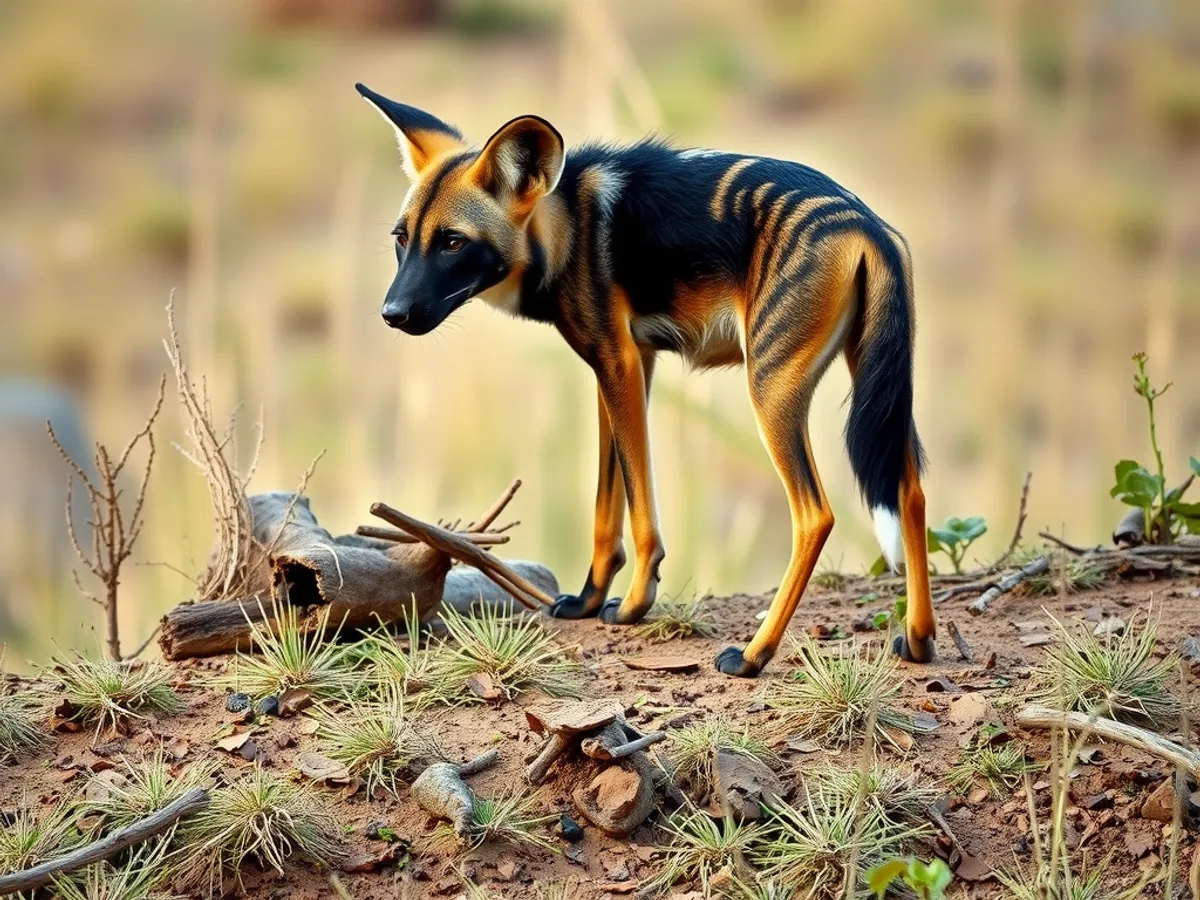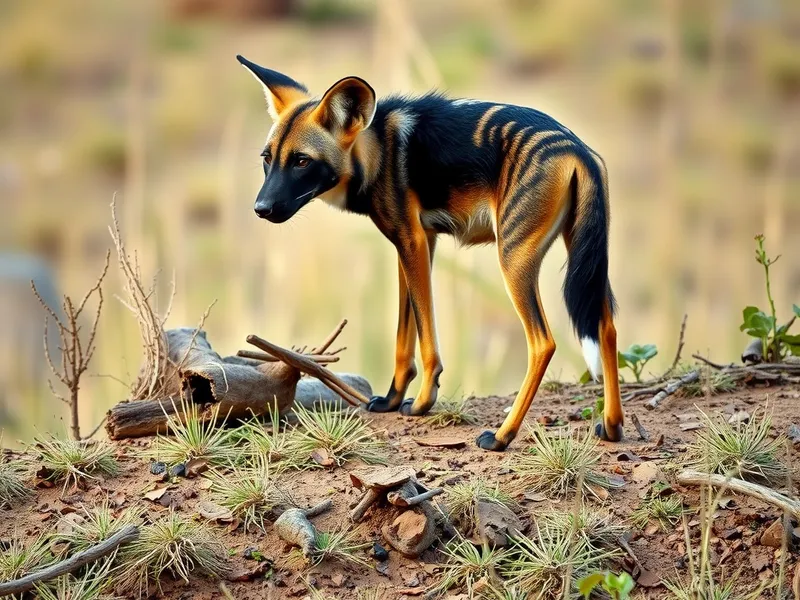
Black-backed Jackal
Canis mesomelas

Meet the Black-backed Jackal
The Black-backed Jackal is a medium-sized canid native to eastern and southern Africa. Recognized by its reddish-brown body and distinctive black 'saddle' running down its back, this jackal is highly adaptable and occupies a range of habitats from savannas to arid deserts. It is an opportunistic omnivore, feeding on small mammals, birds, insects, fruit, and even carrion. Black-backed Jackals are known for their sharp vocalizations, forming long-term monogamous pairs that cooperate in raising their young. They play an important ecological role as both predator and scavenger in their ecosystems.
Classification
Mammal
Habitat
Savanna
Diet
Omnivore
Lifespan
8-12 years
Conservation
Least Concern
Weight
6-13 kg
📖Fascinating Facts
Distinctive Appearance
The Black-backed Jackal is easily recognized by the black fur running along its back, contrasting with its reddish sides and white underparts.
Family Life
Black-backed Jackals are monogamous and both parents help raise the pups, sometimes aided by older siblings from previous litters.
Vocal Communicators
They communicate with a range of sounds, including yelps, howls, and cackles, often to mark territory or keep in contact with family members.
📋Detailed Description
The Black-backed Jackal (Lupulella mesomelas) is a slender, medium-sized canid, typically weighing between 6 and 13 kg and measuring 38–48 cm at the shoulder, with a body length of 60–90 cm excluding the bushy tail. Its most distinctive feature is the prominent black or silver-gray saddle running from the nape to the base of the tail, contrasting sharply with the reddish-tan flanks, legs, and face. The ears are large and pointed, aiding in acute hearing, while the muzzle is narrow and elongated, well-suited for probing into crevices and burrows. The coat is dense and coarse, providing insulation in both hot and cold climates. Black-backed Jackals are highly adaptable, occupying a wide range of habitats from open savannas and woodlands to arid deserts and coastal scrublands. They are primarily crepuscular, being most active at dawn and dusk, but may shift to nocturnal activity in areas with high human presence. Socially, they form long-term monogamous pairs, often accompanied by offspring from previous litters who assist in rearing new pups. Their vocal repertoire is extensive, including yelps, howls, and a characteristic 'ki-yi' alarm call. As both predators and scavengers, they play a crucial ecological role in controlling populations of small vertebrates and cleaning up carrion.
💡 Did you know?
Despite their small size, Black-backed Jackals can defend kills from much larger predators like hyenas and even leopards through teamwork and boldness.
🔬Research & Sources
Wikipedia Summary
The black-backed jackal, also called the silver-backed jackal, is a medium-sized canine native to eastern and southern Africa. These regions are separated by roughly 900 kilometers.
Last Modified: 4/21/2025
🎭Behavior & Social Structure
Black-backed Jackals exhibit complex social behaviors, typically living in pairs or small family groups. Territorial boundaries are maintained through scent marking and vocalizations, with territories ranging from 2 to 20 square kilometers depending on resource availability. Hunting is usually solitary or in pairs, targeting rodents, hares, birds, reptiles, and insects, but they are also known to scavenge from larger carnivore kills and human refuse. Cooperative hunting has been observed, especially when targeting larger prey such as young antelopes. They cache surplus food by burying it in shallow holes. Daily routines involve patrolling territory, foraging, and resting in shaded areas or burrows during the hottest parts of the day. Jackals communicate through a variety of calls, body postures, and tail movements, and are known for their intelligence and problem-solving abilities.
👶Reproduction & Life Cycle
Breeding is seasonal in southern populations (typically May–August) but may occur year-round in equatorial regions. Black-backed Jackals are monogamous, with pairs maintaining strong bonds and sharing parental duties. After a gestation period of approximately 60–63 days, females give birth to litters of 1–9 pups (average 4–6) in dens dug by the parents or appropriated from other animals. Both parents, and often older offspring, participate in feeding and guarding the pups. Pups are weaned at 8–10 weeks but may remain with the family group for up to a year, sometimes assisting in raising subsequent litters. Sexual maturity is reached at 11 months, but dispersal to establish new territories may be delayed by competition or resource availability.
🛡️Adaptations & Survival
Black-backed Jackals possess several adaptations for survival in diverse and often harsh environments. Their keen senses of hearing and smell aid in detecting prey and avoiding predators. The black saddle may provide camouflage in dappled light or serve as a visual signal to conspecifics. Their omnivorous diet and opportunistic feeding strategies allow them to exploit a wide range of food sources, from insects and fruits to vertebrate prey and carrion. Behavioral flexibility—such as shifting activity patterns in response to human disturbance—enhances their resilience. Their social structure, with cooperative breeding and territory defense, increases offspring survival and resource acquisition. Physiologically, they are capable of surviving with minimal water intake by deriving moisture from food.
📚Research Sources
🎨Cultural Significance
Black-backed Jackals feature prominently in African folklore and mythology, often depicted as cunning tricksters or symbols of adaptability. In some cultures, they are associated with the afterlife or serve as totems. Their scavenging habits have led to both positive and negative perceptions: while valued for cleaning up carrion, they are sometimes maligned as pests. Traditional uses are limited, but jackal pelts have occasionally been used for clothing or ritual purposes.
🔬Recent Research & Discoveries
Recent genetic studies have clarified the evolutionary relationships within African jackals, leading to the reclassification of the Black-backed Jackal from the genus Canis to Lupulella. Ongoing research focuses on their role as disease reservoirs, particularly for rabies, and their interactions with expanding human populations. Studies of their vocalizations have revealed sophisticated communication systems, while ecological research highlights their importance in regulating prey populations and facilitating nutrient cycling through scavenging. There is also interest in their behavioral plasticity and adaptability in response to environmental change.
🎥Wildlife Videos

Black-backed Jackal: The Hidden Warrior of African Savanna
The Black-backed Jackal, also known as the Silver-backed Jackal, is a medium-sized canid found across Sub-Saharan Africa.
Familiarity With Animals (FWA)

Wildlife Of Jackals | Ultra HD net geo wild documentary | wildwide life
natgeonational #geographic #natgeowildnational #geographicwild Facts About Jackal Sure! Jackals are fascinating animals with ...
WildWide Life

Black-backed Jackal: Africa's Adaptable Hunter!
Discover the fascinating world of the Black-backed Jackal, one of Africa's most adaptable and cunning predators. In this video, we ...
EdZoo Biz

RESCUED Black-Backed Jackal and an Update on the ORPHANED Rhino
Join us this week as we bring you an update from the Wildlife Rehabilitation Centre. We're thrilled to share the incredible progress ...
Shamwari TV

BLACK-BACKED JACKAL: The most arrogant and resourceful Dog in Africa!
The black-backed jackal belongs to the wolf family but falls significantly short in size compared to the gray wolf. Typically, their ...
WILDOPEDIA

black backed jackal tribute
Song "Skinwalker Moon" by Robert Mirabal.
Kinga Kucyk
🌍Habitat Information
The Black-backed Jackal typically inhabits Savanna environments. Black-backed Jackals have adapted to their environments with specialized features and behaviors.
Primary Habitat:
Savanna
More detailed habitat information will be available soon.
🛡️Conservation Status
The Black-backed Jackal is currently classified as Least Concern. Conservation efforts are crucial for preserving this species for future generations.
Common Threats:
- 🏠Habitat loss and fragmentation
- 🌡️Climate change impacts
- 🎯Hunting and poaching
- 🏭Human-wildlife conflict
⚠️Threats & Conservation Challenges
While currently listed as Least Concern by the IUCN, Black-backed Jackals face localized threats including habitat loss, persecution by farmers (due to predation on livestock and poultry), and disease transmission (notably rabies and canine distemper). In some regions, they are subject to culling and poisoning campaigns. However, their adaptability and generalist diet have enabled them to persist and even thrive in human-modified landscapes. Population trends are generally stable, but ongoing monitoring is necessary, particularly in areas experiencing rapid land-use change or intensified conflict with humans.
🔬Scientific Classification
Scientific Name
Canis mesomelas
Classification Hierarchy
🔍 About Taxonomic Classification
Taxonomic classification is a hierarchical system used by scientists to classify and organize living organisms based on shared characteristics and evolutionary relationships.
The system moves from broad categories (Kingdom) to increasingly specific ones, with each animal's scientific name typically consisting of its Genus and species.
📝Community Notes
Share your observations and insights about the Black-backed Jackal with our community of wildlife enthusiasts.
Join Our Community
Sign in to share your observations and connect with fellow wildlife enthusiasts.
Sign In to ContributeNo community notes yet
Be the first to share your observations about the Black-backed Jackal!
Explore Black-backed Jackal
Select a tab above to learn more about this amazing animal.
📸Photo Gallery
No photos available for this animal yet.
🌟Discover More Wildlife
Continue your journey of discovery with more fascinating animals from our database
